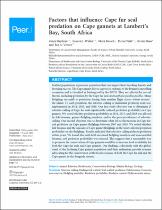| dc.contributor.author | Strydom, Zanri | |
| dc.contributor.author | Waller, Lauren J. | |
| dc.contributor.author | Brown, Mark | |
| dc.date.accessioned | 2022-07-12T07:42:51Z | |
| dc.date.available | 2022-07-12T07:42:51Z | |
| dc.date.issued | 2022 | |
| dc.identifier.citation | Strydom, Z. et al. (2022). Factors that influence cape fur seal predation on cape gannets at Lambert’s bay, South Africa. PeerJ, 10, e13416. https://doi.org/10.7717/peerj.13416 | en_US |
| dc.identifier.issn | 2167-8359 | |
| dc.identifier.uri | https://doi.org/10.7717/peerj.13416 | |
| dc.identifier.uri | http://hdl.handle.net/10566/7587 | |
| dc.description.abstract | Seabird populations experience predation that can impact their breeding density and
breeding success. The Cape gannet Morus capensis is endemic to the Benguela upwelling
ecosystem and is classified as Endangered by the IUCN. They are affected by several
threats, including predation by the Cape fur seal Arctocephalus pusillus pusillus. Many
fledglings succumb to predation during their maiden flight across waters around
the island. To curb predation, the selective culling of individual predatory seals was
implemented in 2014, 2015, and 2018. Our first study objective was to determine if
selective culling of Cape fur seals significantly reduced predation probability on Cape
gannets. We tested whether predation probability in 2014, 2015, and 2018 was affected
by fish biomass, gannet fledgling numbers, and/or the presence/absence of selective
culling. | en_US |
| dc.language.iso | en | en_US |
| dc.publisher | PeerJ | en_US |
| dc.subject | Animal behavior | en_US |
| dc.subject | Biodiversity | en_US |
| dc.subject | Conservation Biology | en_US |
| dc.subject | Marine Biology | en_US |
| dc.subject | Zoology | en_US |
| dc.title | Factors that influence cape fur seal predation on Cape gannets at Lambert’s bay, South Africa | en_US |
| dc.type | Article | en_US |

